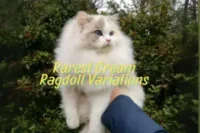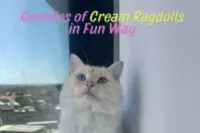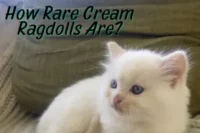Blue Point Ragdoll Colors Variations & Patterns Explained
Published: 15 Aug 2025
If you’ve ever locked eyes with a Blue Point Ragdoll, you will know exactly why our hearts melt for them. Those dreamy blue eyes, that soft-as-a-cloud fur and the gentle bluish-gray “points” on their face, ears, paws and tail… it’s the kind of beauty you don’t forget.
We lived with these gorgeous fluffballs for years and every day they still manage to surprise us whether it’s by curling up in the sun and looking like living art or by chasing a toy like a kitten half their age. And while the classic blue point is stunning on its own, did you know there are many variations and patterns that make each cat unique?
From the snowy elegance of a Blue Point Bicolor Ragdoll to the striking stripes of a Blue Lynx Point, and even rare beauties like the Blue Cream Tortie Point, every variation has its own charm and personality. Some wear perfect little white “mittens,” others have a painter’s brushstroke of cream across their fur, and some look like they stepped straight out of a storybook.
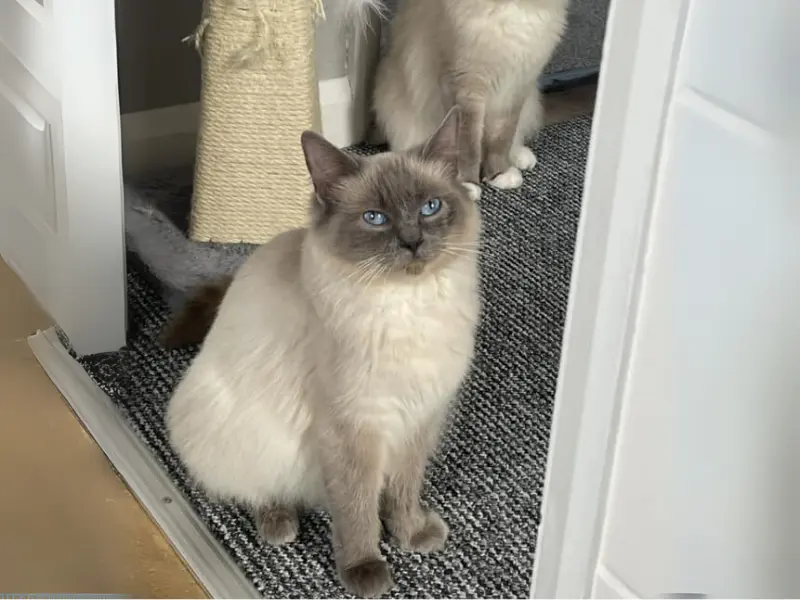
In this guide, we’re going to explore every blue point pattern we’ve met (and snuggled!) over the years. We’ll talk about what makes them special, how to recognize each type, and share real-life tips from our own Ragdoll adventures. So grab a cup of tea, find a comfy spot, and let’s take a whisker-to-tail journey into the wonderful world of Blue Point Ragdoll colors and patterns.
What Makes a Blue Point Ragdoll Unique?
Blue Point Ragdolls have a way of catching the light and our hearts like no other. Their “blue” is not a true blue like the sky but a soft, silvery-gray shade that gives them a dreamy, elegant look. This color appears only on their face, ears, paws and tail while the rest of their body is a lighter, creamy tone. It’s like nature painted them with a gentle watercolor brush.
We sometimes hear people ask, “Why are they called blue if they’re gray?” The answer is simple: in cat color genetics, “blue” refers to a diluted (lightened) version of black. In the case of Blue Point Ragdolls, their seal point coloring is diluted into that beautiful soft gray. Don’t worry, though there’s no science exam here! All you really need to know is that it makes them irresistibly gorgeous.
Over the years, we have noticed that their pale, gentle coloring gives them an extra soft and serene presence. They just feel calm, even if they still have a playful streak that comes out whenever a feather toy appears.
If you are new to the world of Ragdolls, understanding the patterns within the Blue Point family is the key to appreciating just how many gorgeous variations there are. Some have white mittens, some have bold white “V” masks and others have delicate tabby stripes or splashes of cream.
Classic Blue Point Ragdoll
The Classic Blue Point Ragdoll is what most people picture when they hear the words “Blue Point.” It’s the timeless beauty of the Ragdoll world — soft, bluish-gray points on the face, ears, paws and tail with a creamy and velvety body in between. They look like they were painted by an artist who specializes in elegance.
We have shared our home with several classic blue points and no matter how many years pass, their beauty still makes us stop and stare. There’s just something magical about the way their pale body fur blends into the cooler gray tones on their points. And those deep blue eyes? They are like little oceans you can get lost in.
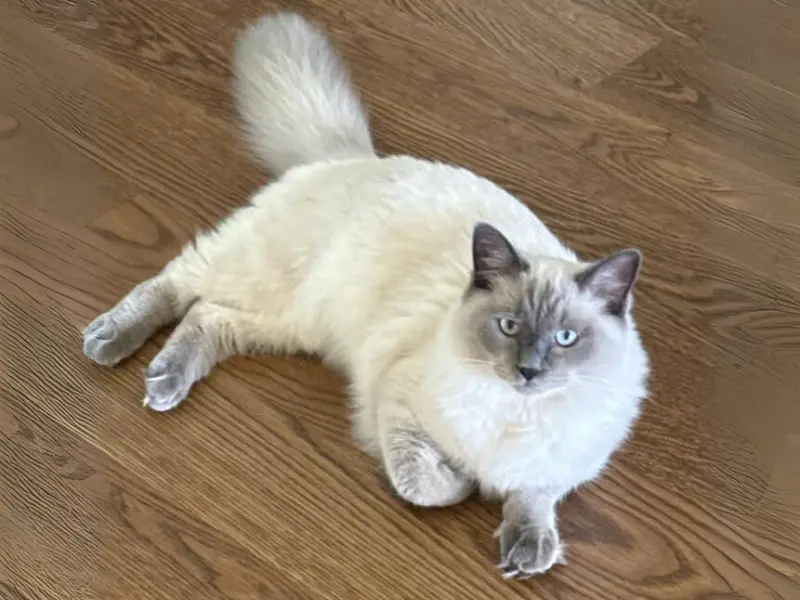
How to Recognize a Classic Blue Point
- Soft, silvery-gray points on ears, face mask, tail and paws.
- Creamy or light beige body fur.
- No white markings— the points are uninterrupted by mittens or blazes.
- Deep sapphire-blue eyes (a Ragdoll trademark).
Personality and Temperament
Classic Blue Points are known for their gentle, affectionate nature. In our home, they are the cats who love to stretch out beside us while we read or nap. They’re calm but don’t be fooled — they will still leap for a feather wand or chase a ball if the mood strikes.
We have noticed they tend to be especially “people-oriented.” Our classic blue point, Luna, follows us from room to room, always choosing a spot nearby but never underfoot. It’s like she knew exactly how close to being comfortable.
Care Tips for the Classic Blue Point
- Brushing: Once or twice a week keeps their coat smooth and mat-free.
- Playtime: Even though they are calm, daily play helps them stay fit and happy.
- Sunlight: A nap in the sun can slightly warm their coat tone — don’t worry, it’s normal and beautiful.
Blue Point Mitted Ragdoll
If the classic blue point is elegant, then the Blue Point Mitted Ragdoll is elegance with a dash of pure cuteness. Those perfect little white “mittens” on their front paws and white boots on their back legs make them look like they are always dressed for a polite tea party… or ready to bake cookies with us in the kitchen.
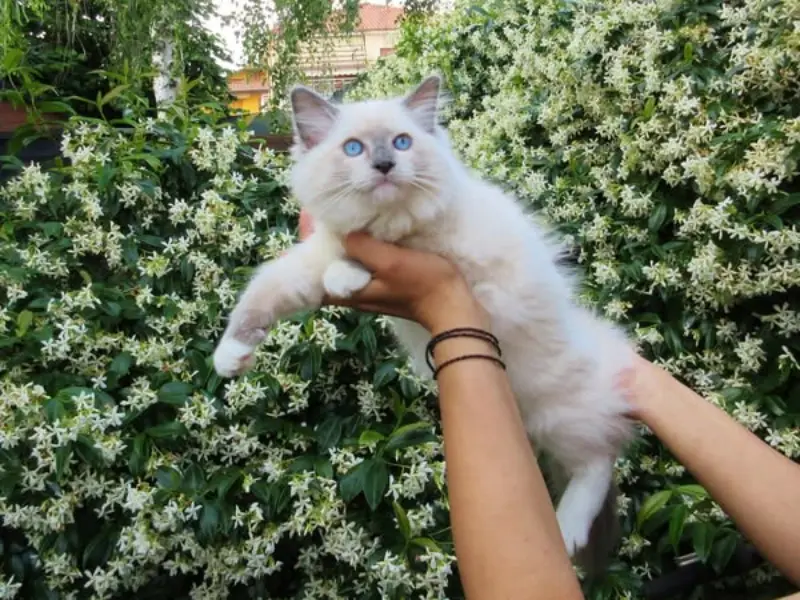
We have had a few mitted blue points in our home over the years and they always seem to have this sweet, almost gentle expression. Maybe it’s the white chin and symmetrical markings or maybe it’s just their naturally loving personality. Either way, they are impossible not to adore.
How to Recognize a Blue Point Mitted
- Soft bluish-gray points on the face, ears and tail.
- White front paws (“mittens”) and white hind legs (“boots”).
- White chin and often a narrow white belly stripe.
- Optional blaze— a thin or wide white line running up the nose (not all have it).
- Same deep blue Ragdoll eyes we all melt for.
Personality and Temperament
Our blue point mitteds have always been cuddle champions. They flop beside us, roll onto their backs and look up with those wide, trusting eyes that say, “Please, more belly rubs.”
We have also found them to be a little playful without being wild. This is a kind of cat that will happily chase a toy mouse but then promptly curl up in your lap afterward. One of our’s, Milo, had a habit of bringing us his favorite toy every night before bed as if to say, “Here, I saved this for you.”
Care Tips for the Blue Point Mitted
- Coat care: Weekly brushing keeps their fur sleek and prevents tangles around the white areas.
- White fur TLC: If their chin or mittens get a bit stained (from food or play), a soft damp cloth works wonders.
- Gentle handling: They are usually easy-going but they thrive on calm affection and daily attention.
Blue Point Bicolor Ragdoll
If there were a “most photogenic Ragdoll” award, the Blue Point Bicolor would win paws down. This variation is instantly recognizable thanks to its crisp white markings, soft gray points and that famous upside-down white “V” mask on the face. Pair that with deep blue eyes and a silky coat, and you have a cat that looks like it belongs on the cover of a magazine.
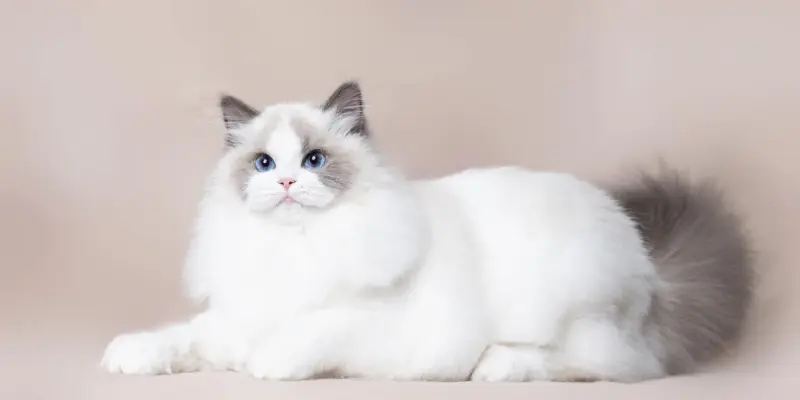
When our first blue point bicolor, Misty, came home, we couldn’t stop taking pictures of her. She had the perfect “V” and loved sitting by the window where the light made her fur almost glow. Even visitors who weren’t “cat people” couldn’t resist her charm.
How to Recognize a Blue Point Bicolor
- Blue-gray points on ears and tail, sometimes with light shading on the back.
- Bright white “V” shape on the face, starting at the forehead and going down the nose.
- Fully white legs, chest and belly.
- Blue eyes that really pop against the white fur.
Personality and Temperament
Blue point bicolors are often confident and social. Ours tend to be the first to greet guests, hopping onto laps like they have known them forever. They’re playful but also mellow, making them great companions for families, singles or even multi-pet homes.
Our Misty had a habit of “talking” to us in soft chirps whenever she wanted attention which was often. She also adored gentle grooming sessions, probably because she knew how fabulous she looked afterward.
Care Tips for the Blue Point Bicolor
- Keep that white bright: A quick gentle wipe with a soft cloth helps keep their fur looking fresh, especially around the face.
- Show grooming: If you plan to show your Ragdoll, regular brushing and occasional professional grooming can help maintain their perfect coat.
- Playtime mix: Combine interactive toys with cuddle breaks, they love both.
Blue Lynx Point Ragdoll
The Blue Lynx Point Ragdoll is like a classic blue point dressed up in the softest, most elegant stripes you have ever seen. Instead of solid blue-gray points, they have delicate tabby striping on their face, legs and tail. It’s a look that makes them stand out instantly, almost like they have put on a subtle, natural eyeliner and matching accessories.
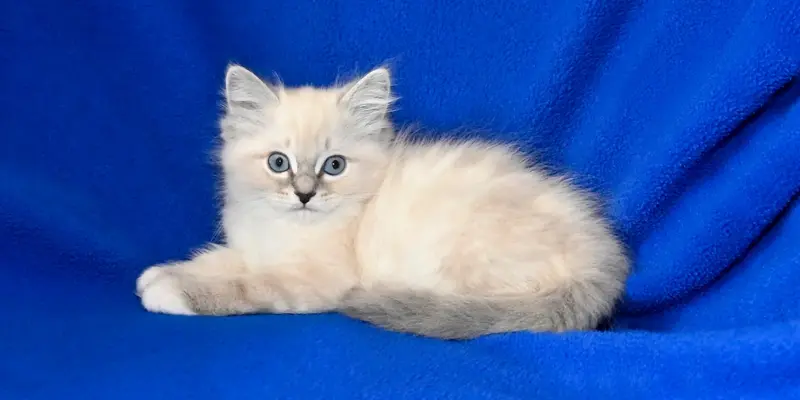
The first time we brought home a blue lynx point, we couldn’t stop admiring her in the sunlight. Her stripes seemed to shimmer and that little “M” shape on her forehead gave her an extra dose of personality. Even now, we find ourselves taking way too many photos whenever the light hits just right.
How to Recognize a Blue Lynx Point
- Soft blue-gray points with faint tabby striping.
- Distinct “M” marking on the forehead.
- Blue-gray striped tail and faint rings around the legs.
- Creamy body fur with slightly cooler tones.
- Striking deep blue eyes that contrast beautifully with the patterned face.
Personality and Temperament
Our blue lynx points have been curious, clever and just a little cheeky. They are the ones who figure out how to open cupboard doors or quietly borrow toys from the other cats.
Despite their playful side, they’re still true Ragdolls at heart, pure, gentle, affectionate and happiest when they’re near their humans. One of ours, Willow, loved to curl up right beside us in bed, pressing her striped tail against our legs as if to make sure we didn’t wander off in the night.
Care Tips for the Blue Lynx Point
- Photography tip: Their stripes really shine in natural light, so keep the camera ready during sunny naps.
- Grooming: A weekly brushing is usually enough but pay extra attention during shedding season to keep their coat smooth.
- Play enrichment: Puzzle feeders and interactive toys keep their clever minds engaged.
Blue Lynx Point Bicolor Ragdoll
If the Blue Lynx Point is elegant and the Blue Point Bicolor is striking, then the Blue Lynx Point Bicolor is the best of both worlds. Imagine soft blue-gray tabby stripes paired with the crisp white “V” mask and snowy legs of a bicolor. It’s a combination that looks like high-end fashion but with the purr-sonality of a snuggly teddy bear.
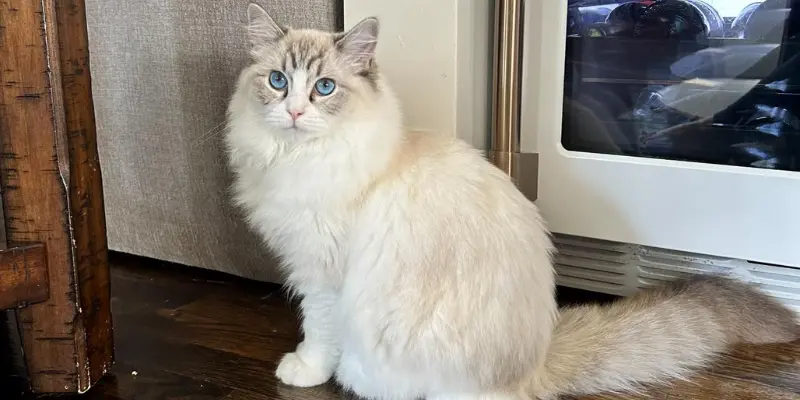
Our first blue lynx point bicolor, Ivy, had markings so perfectly balanced that people often asked if she was painted. Her striped tail curled like a question mark whenever she was curious (which was all the time) and her bright white face fur made those sapphire eyes look even bigger.
How to Recognize a Blue Lynx Point Bicolor
- Blue-gray lynx striping on ears, face mask and tail.
- White “V” shape on the face, starting between the eyes and running down the nose.
- Fully white legs, chest and belly.
- Creamy body coat with cool undertones.
- Deep blue eyes framed by both stripes and white fur.
Personality and Temperament
In our experience, blue lynx point bicolors are social butterflies. They are confident around guests, curious about everything new and always ready for a game of chase. Ivy loved meeting visitors and often greeting them with a soft head bump like they were already friends.
At the same time, they are total cuddle bugs. These cats have no problem flopping across your lap and refusing to move until you’ve given them a proper belly rub session.
Care Tips for the Blue Lynx Point Bicolor
- White fur care: A quick wipe with a damp, soft cloth keeps their face and paws looking fresh.
- Photo moments: Capture their “V” mask in soft daylight for the most striking portraits.
- Balanced play: Mix short bursts of active play with plenty of downtime for cuddles.
Blue Lynx Point Mitted Ragdoll
If you have ever seen a Blue Lynx Point Ragdoll and thought, “That cat needs a pair of matching socks,” then you have just described the Blue Lynx Point Mitted. This gorgeous variation combines the gentle tabby striping of the lynx pattern with the adorable white mittens and boots of the mitted pattern which is the result of pure, heart-melting cuteness.
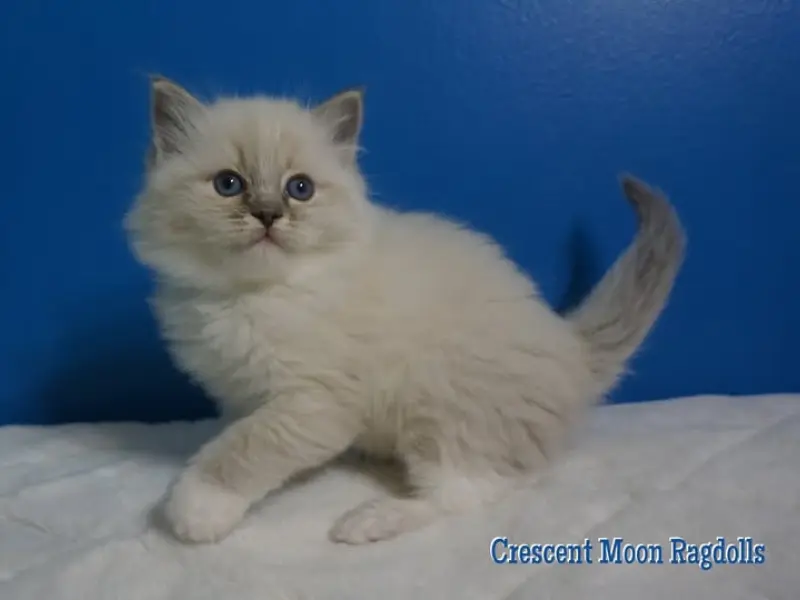
Our first blue lynx point mitted, Jasper, had the neatest little white paws we’d ever seen. He would sit with them perfectly lined up like he was posing for a formal portrait. And when he walked across the room, it was impossible not to notice those “socked” feet padding softly toward us.
How to Recognize a Blue Lynx Point Mitted
- Blue-gray lynx stripes on the face mask, ears and tail.
- White front paws (“mittens”) and white hind legs (“boots”).
- White chin and a narrow white belly stripe.
- Optional white blaze on the nose (some have it, some don’t).
- Creamy body coat with cool undertones and faint shading.
- Striking blue eyes framed by a mix of stripes and white markings.
Personality and Temperament
Blue lynx point mitteds are often playful charmers. They tend to be very people-focused and always keep an eye on where we are and what we’re doing. Jasper would trot after us from room to room, then plop down right in our path as if to say, “You weren’t going anywhere without petting me first.”
They balance energy and calm beautifully. They will happily bat around a toy mouse but just as easily curl up beside you for a quiet nap afterward.
Care Tips for the Blue Lynx Point Mitted
- Brushing: Weekly brushing keeps the white areas bright and the coat tangle-free.
- Face care: A soft cloth works well for gently cleaning the chin and blaze area if needed.
- Interactive fun: They love games where they can “pounce” — like wand toys or rolling balls.
More Unique Blue Point Variations
While the classic blue points and their lynx or mitted cousins are well-known, there’s a whole world of rarer Blue Point patterns that can make your heart skip a beat. These beauties often combine colors or patterns in unexpected ways, creating cats that truly look like one-of-a-kind works of art.
We have been lucky enough to meet some of these unique variations over the years and every time, we are reminded of how endlessly fascinating Ragdoll coloring can be. Let’s start with one that always makes us think of soft watercolor paintings…
Blue Cream Point Ragdoll
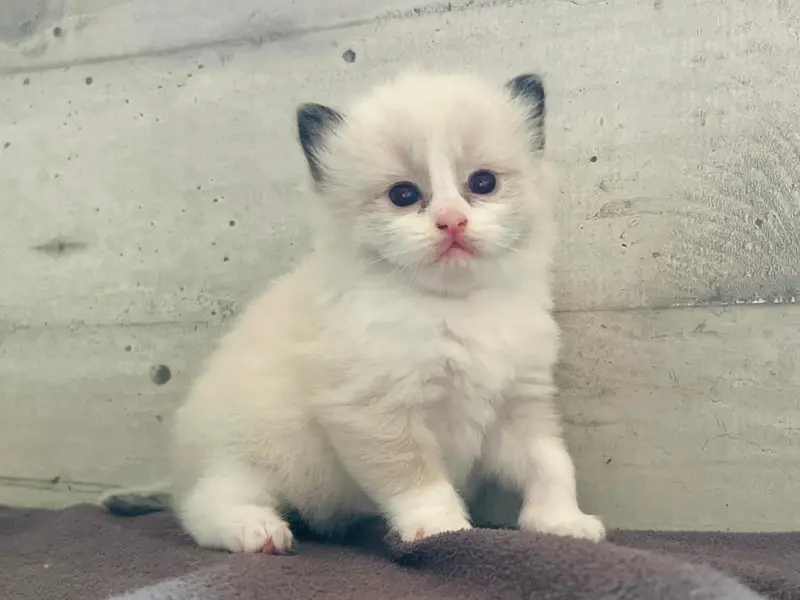
The Blue Cream Point Ragdoll wears a dreamy blend of bluish-gray and pale cream on their points which is almost as if someone gently brushed warm sunlight into the cool gray. These cream patches can appear on the ears, face, paws or tail and no two cats are ever marked exactly the same.
We once cared for a blue cream point named Daisy who had the sweetest little cream patch right above her left eye. It gave her the look of a permanent “raised eyebrow” which suited her curious personality perfectly.
They are as affectionate as they are beautiful and we have found their gentle mix of colors makes them stand out even in a room full of Ragdolls.
Blue Cream Lynx Point Ragdoll
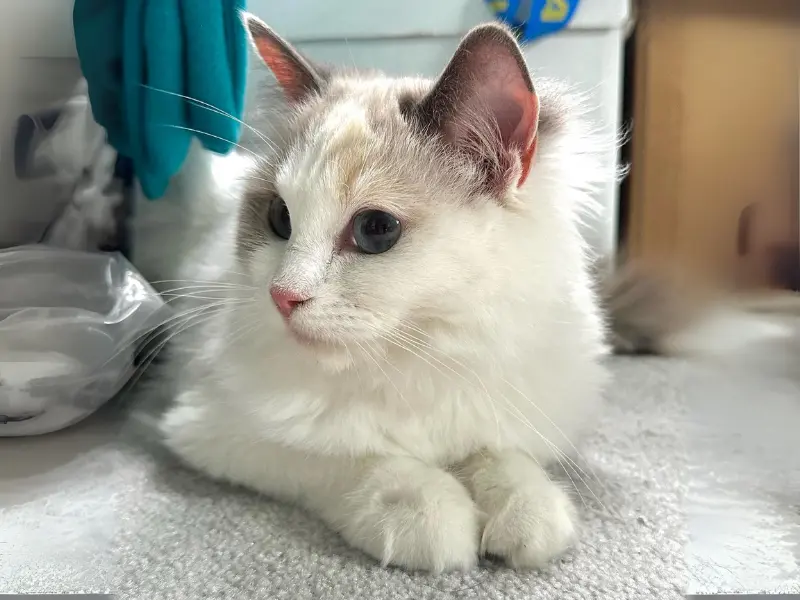
If you take the soft, painterly mix of bluish-gray and cream from the blue cream point and then add the elegant tabby striping of a lynx pattern, you get the Blue Cream Lynx Point Ragdoll — a true stunner!
Their stripes are usually a mix of blue-gray and warm cream tones, creating a delicate marbled look on the face, ears and tail. The body remains light and creamy, which makes those patterned points pop even more.
One of our fosters, Bella, had a perfect “M” shaped marking on her forehead in cream and gray, framed by big blue eyes. She looked like she’d stepped straight out of a storybook.
Blue Tortie Point Ragdoll
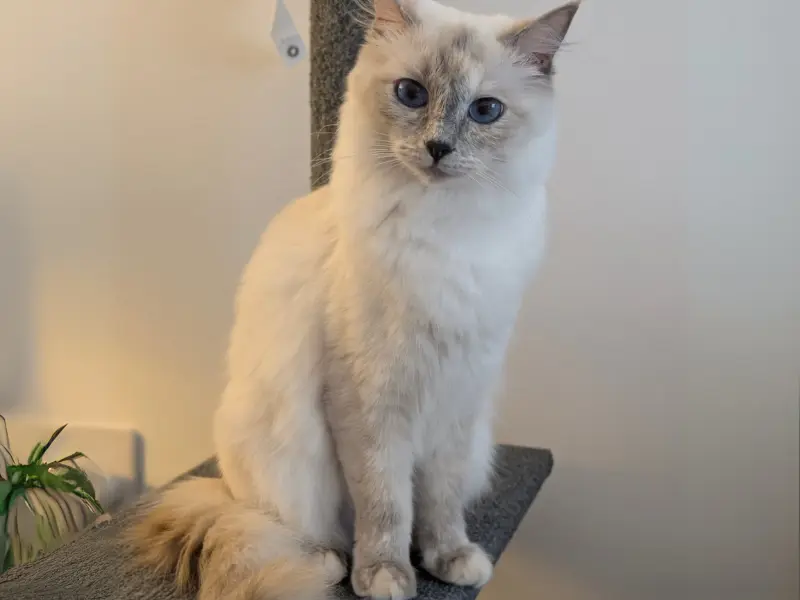
The Blue Tortie Point Ragdoll is like a little work of abstract art. Imagine the soft blue-gray points of a classic blue point but sprinkled with random patches of warm cream or pale orange, that’s the magic of the tortie pattern.
Every blue tortie point is unique. Some have tiny cream flecks on their ears or nose while others wear bold patches on their tail or paws. We once cared for a tortie named Poppy who had a single cream spot on her nose, making it look like she’d just booped a paintbrush.
Torties are known for having a bit of “spice” in their personality but our experience has shown that Ragdoll torties keep their signature sweet and laid-back nature — just with a little extra playful sass.
Blue Cream Tortie Point Ragdoll
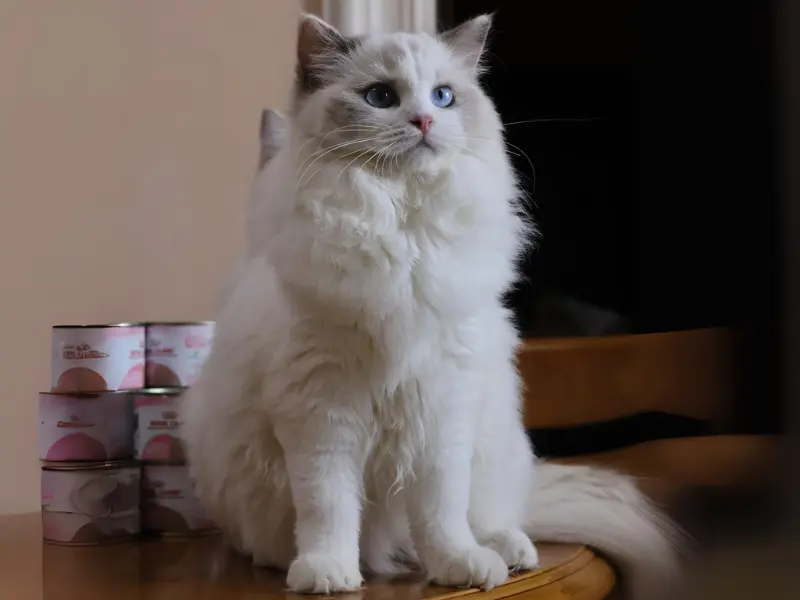
The Blue Cream Tortie Point Ragdoll takes the softness of blue-gray points, swirls in pale cream and adds that charming tortie randomness. The result? A cat that looks like a hand-painted porcelain doll.
Compared to the classic blue tortie, the blue cream tortie’s warm patches are lighter and creamier, giving their face and ears a gentler, pastel-like look. We had one sweet girl named Misty who looked as if someone had brushed delicate cream clouds over her gray ears. She was just as cuddly as she was beautiful.
What we love most about this variation is how the lighter tortie markings can make their blue eyes seem even brighter like little sapphires peeking out from a soft watercolor canvas.
Blue Point Mink Ragdoll
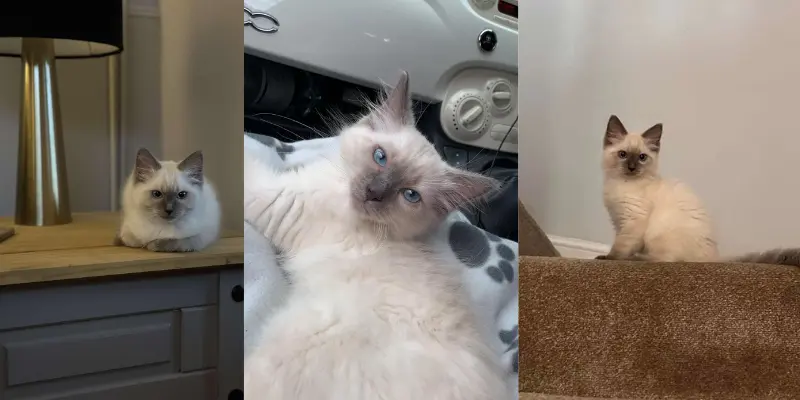
The Blue Point Mink Ragdoll is a rare and luxurious twist on the classic blue point. The word “mink” here doesn’t mean fur from another animal but it’s a special coat gene that gives the Ragdoll’s fur an extra-silky, velvety texture and a slightly deeper, richer color.
Their points (ears, face, paws and tail) are the same lovely bluish-gray but the body coat is warmer and creamier than in traditional blue points. This gives them a soft “chocolate milk” tone that feels so cozy and unique.
We once looked after a mink boy named Jasper and oh, the cuddles! His fur felt like cashmere under our fingers and his gentle purr made every brushing session pure bliss.
Because of their unusual coat texture and deeper color contrast, blue point mink Ragdolls often look a little more “regal” but don’t let that fool you. They are still the same lovable, floppy cuddle-buddies we adore.
Which Blue Point Variation Matches Your Lifestyle?
Choosing a Blue Point Ragdoll isn’t just about looks, it’s also about finding a personality and care style that fits purr-fectly with your home and heart. While every Ragdoll is famously sweet, each color variation can come with its own little quirks. Here’s a quick guide to help you decide which one might be your ideal cuddle buddy.
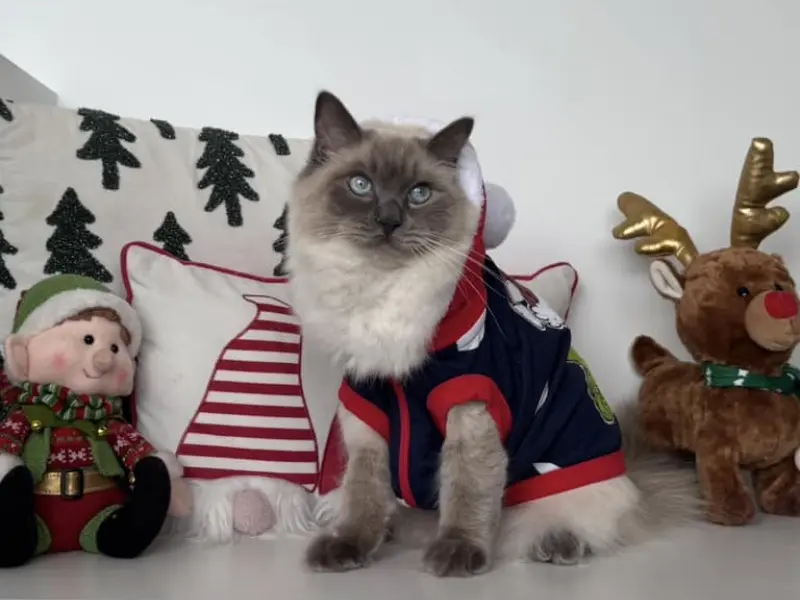
Blue Point Mitted
- Temperament: Calm, affectionate and loves curling up beside you.
- Grooming Needs: Low to moderate— their coat stays pretty neat with regular brushing.
- Activity Level: Moderate. They enjoy playtime but are happiest as gentle lap loungers.
💙 Best for: Cat parents who adore quiet evenings, soft purrs and a loyal shadow by their side.
Blue Point Bicolor
- Temperament: Sociable and people-oriented, often the “host” when guests visit.
- Grooming Needs: Moderate— weekly brushing keeps them silky and tangle-free.
- Activity Level: Moderate to high. They enjoy play sessions and can be a bit cheeky.
💙 Best for: Families or anyone who loves a social, playful cat who still makes time for cuddles.
Blue Lynx Point
- Temperament: Curious, intelligent and a touch mischievous.
- Grooming Needs: Moderate— their beautiful tabby-like markings deserve a gentle brush a few times a week.
- Activity Level: High compared to other Ragdolls — they will follow you around and want to be part of everything.
💙 Best for: Active homes that enjoy an elegant, playful companion who keeps life interesting.
Blue Cream or Blue Tortie Points
- Temperament: Sweet, affectionate and often a little sassy in the most adorable way.
- Grooming Needs: Moderate— their multi-colored coats look best with regular brushing.
- Activity Level: Moderate — they love play but also adore their beauty naps.
💙 Best for: Cat lovers who enjoy a mix of beauty, personality and snuggles.
Blue Point Mink
- Temperament: Gentle, loving and a little more reserved than others at first.
- Grooming Needs: Low— their silky coat rarely mats but they still enjoy brushing.
- Activity Level: Moderate— they are playful but tend to prefer quiet, cozy moments.
💙 Best for: Someone who wants a soft, velvety cuddle buddy with a calm, serene personality.
Ending, With Beauty of Blue Point Ragdolls
From the classic Blue Point Mitted with its sweet white paws to the striking Blue Point Bicolor and from the elegant Blue Lynx Point to the rare and charming Blue Cream and Blue Tortie Points— each variation has its own special sparkle. And let’s not forget the velvety-coated Blue Point Mink, whose quiet elegance makes them truly unforgettable.
We have loved sharing these beautiful patterns with you and we’d be over the moon to see your own blue point beauties! Do you have a mitted snuggle bug? A lynx point chatterbox? Maybe a bicolor showstopper? Share your photos and stories in the comments— we’d love to meet them. 🐾💙
No matter which pattern you fall for, a Blue Point Ragdoll will fill your home with love, purrs and a touch of magic.
Frequently Asked Questions– Blue Point Ragdoll Colors & Patterns
Here is the list of FAQs:
A Blue Point Ragdoll has soft bluish-gray points (ears, face, paws and tail) with a lighter, creamy body. It’s one of the most loved Ragdoll color patterns for its dreamy look and gentle personality.
Yes! Like all Ragdolls, they are born white and their blue points slowly develop over the first 2–3 years. Watching their coat bloom is part of the magic.
Blue Point Mitted Ragdolls have white mittens on their paws and sometimes a white chin, while Bicolors have an inverted “V” on their face and more white on their legs and belly.
They are not the rarest Ragdoll color but certain variations like Blue Lynx or Blue Cream are less common and feel extra special.
Their medium-long coat needs brushing once or twice a week to keep it tangle-free. We also make it a bonding time with plenty of cuddles.
It’s a Blue Point with faint tabby-like stripes on the points. This gives them an elegant, frosted look that’s simply stunning.
All Ragdolls are known for their sweet, loving nature. The color doesn’t change their personality but the charm of those blue points might make you fall in love faster!
If you see grayish ears, nose and tail tips starting to appear within a few weeks, they may be a Blue Point. The color will deepen as they grow.

- Be Respectful
- Stay Relevant
- Stay Positive
- True Feedback
- Encourage Discussion
- Avoid Spamming
- No Fake News
- Don't Copy-Paste
- No Personal Attacks



- Be Respectful
- Stay Relevant
- Stay Positive
- True Feedback
- Encourage Discussion
- Avoid Spamming
- No Fake News
- Don't Copy-Paste
- No Personal Attacks


